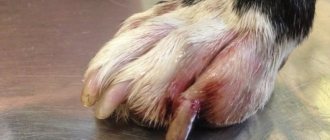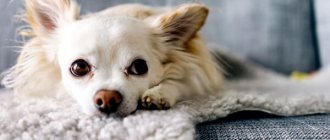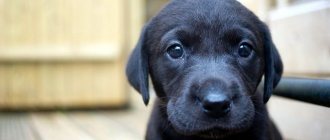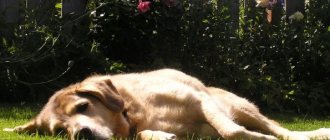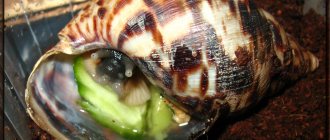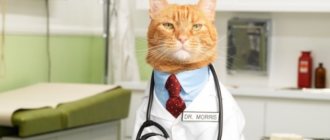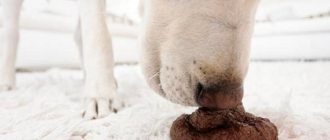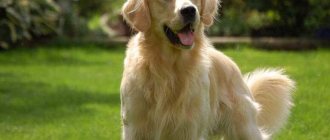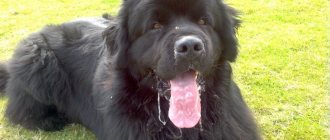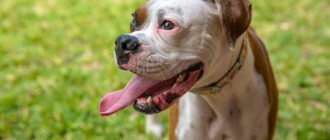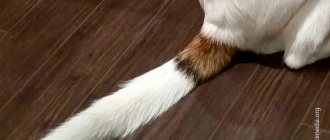Most dogs lick their paws. This is a completely natural grooming process, in this way they remove foreign objects stuck after a walk and clean the fur of dirt. The usual cleaning procedure should alert the owner if the dog bites its paws. Scratching to the point of bleeding, redness and alopecia on the limbs are especially dangerous. If such symptoms are detected, you should carefully examine the animal and contact a veterinarian to determine the causes and prescribe treatment.
Allergy
If your dog's paws are itchy, it could be due to an allergy. Allergies are common and can be caused by the environment, food, or an irritant that comes into contact with your dog's skin.
Redness, dark pigmentation, or brown spots on the paws from constant licking may be signs of an allergy. Washing or drying your dog's paws after going outside will reduce the number of allergens on your dog's skin.
Topical hydrocortisone creams or sprays sold for dogs can temporarily relieve the itching, but more intense licking requires systemic treatment (prescription medications that affect the entire body).
Prevention
It is not difficult to protect your pet from unpleasant diseases. You need to follow the rules of hygiene and inspect the dog’s limbs after a walk.
Hygiene
Expert opinion
Makarenko Svetlana Igorevna
Practicing veterinarian, 15 years of experience.
Long-haired breeds suffer from diaper rash and fungal infections more often than others. Thick fur falls between the toes, gets wet after walking or swimming, dirt accumulates there, creating a favorable environment for the development of bacteria.
The pet's paws are regularly examined, and hairballs are removed approximately once every 2 weeks, cutting it down to the skin.
Nails are trimmed 2 times a month. They should not interfere with the pet's movement. The ingrown stratum corneum rubs the skin, the nail bed becomes inflamed, and the dog feels pain and discomfort and tries to gnaw out the foreign object.
Regular inspection
The pet's paws are examined daily. In summer, there is a danger of ticks, splinters, glass getting under the skin, and getting burned on hot asphalt.
In winter, dogs suffer from ice fragments, reagents, spilled gasoline or motor oil. Wounds identified in a timely manner are treated and bandaged.
It is important to remember that insect bites in dogs cause piroplasmosis. Without timely treatment, this disease is fatal.
Timely vaccination
The procedure helps to avoid common infectious diseases in dogs.
Even if a virus or bacteria gets into the blood, the animal easily transfers the disease, there are no complications.
Enriched diet
The predominance of protein foods (meat) in a dog’s diet leads to the development of dermatitis. The skin becomes dry and itchy. The animal cannot get rid of the itching; it bites its tail and paws.
It is believed that an animal only needs meat, but this statement is fundamentally wrong. Dogs need vitamins and microelements. You can find them in cereals and vegetables.
After the tests, the veterinarian prescribes special synthetic vitamin supplements, which are added to the pet’s natural food.
If the owner cannot prepare a variety of natural foods, the dog is switched to ready-made food. Manufacturers made sure to include all the substances necessary for a pet.
You can choose food according to age, physical activity, and breed.
Drink
Every day your dog needs clean drinking water. The liquid enhances metabolism, improves kidney function, and helps remove toxins from the body faster. If an animal has access to clean, high-quality water, the likelihood of developing allergies and dermatitis is reduced significantly.
Ringworm
Ringworm is a fungal infection that spreads easily through contact with contaminated soil or animals. It is usually found on the paws, as well as the head, ears and limbs of dogs.
Hair loss and redness of the skin may occur, but some animals may have ringworm and not show any signs.
Topical creams, shampoos, and sauces can be helpful in getting rid of ringworm.
Long-haired animals may need to have their hair shaved to prevent re-infestation. This should only be done with pet clippers and you should use a guide comb to avoid pressing too close to the skin.
When to contact the clinic?
You should consult a doctor if your dog chews its paws hard and often until it bleeds, or if there are signs of tissue damage. In this situation, early treatment can prevent dangerous complications, so if you cannot cope with the problem on your own, you need to urgently make an appointment. One of the main purposes of the treatment is diagnostics, which allows us to identify the reason why the dog chews itself. Basic research methods:
- visual examination, collection of the dog’s medical history through an interview with the owner;
- blood chemistry;
- stool analysis;
- microscopic examination of skin scrapings.
The choice of the optimal solution is based on the diagnostic results and the dog’s well-being. Depending on the reasons that caused the problem with the paws, drug therapy, physiotherapy, changes in the rules of maintenance and care may be prescribed. The main tactics for treating dog scratching is to identify the reasons why the dog chews its paws, eliminate symptoms and enhance recovery, and stimulate the animal’s immunity.
Photo: naturaldogcompany.com
Neurosis
This is a psycho-emotional disorder that leads to behavioral disturbances and obsessive manifestations. If the dog itches and chews its paws due to neurosis, the following conditions are recommended:
- emotional and physical peace of the pet;
- restrictions on walks and exercise;
- creating a comfortable and safe place in the house;
- correction of diet, inclusion of vitamins and minerals in the menu;
- increasing time for games, communication and contact with your pet.
Recovery can take a long time; during treatment you should provide the dog with care and affection, which is important for its health. Regularly inspect and treat paws.
Fungal infection
A common reason why a dog begins to actively lick its paws. Against the background of the disease, severe scratching of the skin, bruising and dermatological manifestations are observed. Treatment tactics:
- The doctor selects an antipruritic and antifungal drug (Mycozoral, Clotrimazole).
- Regular treatment of wounds with an antiseptic is prescribed
- Paws should be thoroughly dried after each walk, and prolonged exposure to the street should be avoided.
- Systematic washing of the limbs with a special detergent (Nizoral, Imaverol).
In advanced forms, tablets or injections for intramuscular administration are recommended. Against the background of a fungus, it is important not only to fight the symptoms, but also to strengthen the immune system. That is why it is important to balance the diet and give additional vitamin supplements.
Allergy
Among other problems, it occurs frequently. Allergic manifestations are quickly relieved with medications, but it is important to identify the source of irritation. This could be a food product, flower dust, flavored additives and other external factors. It is recommended to take an allergen test in order to adjust the dog’s diet and lifestyle. If the cause of the pathology was food, then completely exclude this component from the pet’s daily menu.
Photo: flickr.com
Toenail injuries
If your dog continues to lick one paw, he may have a damaged toenail or a partially torn nail. This can happen if it gets caught on grass, fabric or carpet. Bleeding from the dog's nail is common, as well as the dog's paws becoming swollen and uncomfortable.
The claw will improve if you carefully remove the severed part. Medicines for infections and inflammation may also help. Contact your veterinarian for assistance in removing the severed portion of the nail and for medication.
Diagnostics
At an appointment with a veterinarian, an external examination takes place. The veterinarian examines the general condition of the animal, the dog’s oral cavity, and carefully examines the wounds. If matted fur or abnormal nail growth occurs, the animal is sent to a groomer to correct the problems.
If there are no visible injuries, but the animal continues to bite its paws, an in-depth examination is carried out. The doctor takes:
- scrapings to determine allergic reactions or parasites;
- blood chemistry;
- cal.
The question of treatment will arise after receiving the results.
Means for melting snow and ice
Winter snow and salt used to remove ice can also cause skin irritation, causing your dog to lick his paws. Extreme cold and irritation from salt can cause the affected areas to become red. Contact your veterinarian if you suspect your pet's paws are irritated by snow or deicer.
Using boots when walking in winter will help avoid this. You can also use paw wax or dog-safe de-icers for your own yard.
Seeking help from a veterinarian
Why does a puppy eat dirt and stones and what should the owner do?
If your dog rarely licks its paws, you should not contact a veterinarian. This is normal behavior for a pet to maintain its hygiene. If your four-legged pet begins to lick and bite its limbs more often, or its health has worsened, then you should start to worry.
First you need to examine your pet's paws. If they are inflamed and there are bruises, then the dog is sick. She urgently needs veterinary help.
Don't delay getting your animal examined by a veterinarian if its paws are bleeding.
The doctor will examine the dog and take scrapings from the diseased areas. This will help identify the cause of the ailment and prescribe the necessary medications. It is impossible to make a correct diagnosis on your own. If treatment is not started on time, complications are possible.
Demodex mites and scabies
Mites can live on an animal's skin, causing hair loss, crusting, inflammation and itching that causes licking.
There are two types of mites: the demodex mite, which lives deep in the hair follicle, and the scabies mite, which lives on the surface of the skin. Both can cause hair loss, redness, and bacterial infection of the skin.
Demodex mites located on the feet may indicate the presence of an underlying disease, such as Cushing's disease or cancer, that suppresses the immune system.
Ticks can be treated with topical or oral medications. Oral medications used to treat demodex mites (NexGard, Bravecto) and scabies (ivermectin) are available by prescription only.
Lime-sulfur sauces for scabies mites can be purchased over the counter, but they have an unpleasant sulfur odor and may stain animals or light-haired surfaces. Their use should also be supervised by a veterinarian.
Why does a dog chew its tail?
Many people, seeing such a spectacle, think that it is funny, and the dog is just playing. Indeed, this often happens in puppies who are not fully aware of their body parts. However, what to do if this happens to an adult dog? In this case, you need to carefully monitor your pet. Most often this becomes a sign of the presence of some kind of pathology.
Typically, a dog may chew its tail for several reasons:
- Parasites
- Inflammation of the paraanal glands
- Eczema or ringworm
- Tail injuries
- Neurosis and psychological trauma
- Boredom
- Allergy
- Poor nutrition
The dog is chewing his tail
Anxiety and boredom
Anxiety and boredom usually cause a dog to continue licking its paws. Repeated movements calm dogs. Hair loss with thickened, raised skin or mucous granuloma may occur in this area.
A prescription medication that can treat licking granulomas is Synotic with extra banamine.
This combination anti-inflammatory lotion is used to treat damage caused by repeated licking of the same area, often the wrist.
A prescription topical medication may help, but you also need to figure out what's causing your concern. Contact your veterinarian to help you understand the cause and come up with a plan to help your dog.
Causes
Dogs often lick their paws as part of self-grooming. However, if the pet does this too often and starts gnawing on them, especially paying attention to one paw, the reason may be different.
Dandruff
Scales on the coat can indicate dry skin, which may only occur in certain areas or at certain times of the year. A special moisturizing cream rinse designed for dogs and the pet taking omega-3 can eliminate this problem.
Inflammation
Localized inflammation may appear on the paws caused by repeated licking of the area. This is a reaction to severe itching. Hair loss and moist, red skin are often observed.
A topical anti-inflammatory and antimicrobial spray designed for dogs can help treat inflammation. Topical hydrocortisone sprays may also help.
Bacterial infection
Bacterial infections can develop when the skin is damaged. The presence of scabs may be accompanied by redness, flaking of the skin and hair loss.
A medicated shampoo or special wipes used regularly can help restore the normal balance of beneficial bacteria on your pet's skin.
Fungus
This is another source of infection. The presence of fungus contributes to the appearance of itching, unpleasant odor and a feeling of greasy.
To treat fungal infections, medicated shampoos and wipes are used, as well as special medications prescribed by your veterinarian.
Allergy
If your dog's paws itch, it could be due to an allergy. This is a common problem that can be caused by various environmental factors, food, or any irritants that come into contact with the skin.
Redness, dark pigmentation, or brown spots from constant licking or biting may be signs of an allergy. Washing or drying your dog's paws after going outside will reduce the number of allergens on the skin.
Topical hydrocortisone creams or sprays made for animals can temporarily relieve the itching, but proper treatment requires special medications prescribed by veterinarians.
Ringworm
Ringworm is a fungal infection that is spread by contact with contaminated soil or animals. It is usually found on the paws, as well as on the head and ears.
Hair loss and redness of the skin may occur, but some animals may have ringworm and not show any signs.
Topical creams and shampoos can be helpful in getting rid of ringworm.
Long-haired animals may need to have their fur shaved to prevent re-infestation.
Claw injury
If your dog continues to chew and lick only one paw, he may have a damaged nail. This can happen if she gets caught on a carpet, stone, or grass while walking. There is usually bleeding and swelling is visible. The animal is experiencing discomfort.
The situation will improve if the remaining part of the claw is carefully removed. Medicines for infection and inflammation can also help keep the situation from getting worse. Contact your veterinarian for help in removing the torn part of the nail, as well as for the necessary medications.
Burns
Burns can occur if the dog has walked on hot surfaces, or from undiluted chemicals - most often these are cleaning products.
You can see redness, wounds and cracks, blisters on the skin, which is why the pet tends to lick or chew it. In this case, medications must be used for secondary infection or pain relief. The veterinarian may prescribe them.
Reagents
The chemicals used to melt snow and ice in the winter can cause skin irritation, causing your dog to lick or chew his paws. Contact your veterinarian if you suspect this problem.
Using dog boots when walking in winter can help prevent this situation. You can also use special wax or dog-safe compounds for your own yard.
Ticks and parasites
Ticks are parasites that can live in grass and bushes. They often become buried between the toes and paw pads. This can cause discomfort and lead to your dog chewing on them.
It is important to carefully remove the entire tick using a special tool.
Pain
Pain resulting from arthritis of the joints, sprains, and fractures can cause the dog to chew on its paws. The pain may “radiate” to the limb from another area that is out of reach. The affected area may be tender and appear swollen.
Joint supplements and oral medications may help relieve discomfort.
Anxiety and boredom
Anxiety and boredom often cause a dog to chew its paws. Repeated movements calm your pet. Hair loss may occur in this area, and the skin may become covered with wounds.
Using prescription topical medications can help, but you also need to figure out what exactly is causing your concern. A behaviorist and veterinarian can help determine the cause and develop a plan to help your dog.
Insect bites
Your dog may have been bitten or stung by an insect while walking. Pets will lick the affected paw in an attempt to soothe the itching and swelling.
Oral antihistamines and topical steroids are often used to treat these symptoms. Take your dog to the vet immediately if you suspect an insect bite.
Stuck item
An object stuck in the paw - a thorn or a pebble - can provoke biting and licking. The dog will try to eliminate the source of pain. They may be located between the pads of the toes and may be hidden under fur.
Check your dog's paw carefully for any objects. The irritation should disappear as soon as the source of pain is removed.
Cysts and bumps
Cysts can form on your dog's feet, causing your dog to lick his paws. These are fluid-filled swellings that can become trapped by foreign objects, especially between the toes.
Some cysts are growths that may contain thick material and may gradually enlarge over time. In a cyst that is draining, the embedded material may need to be removed.
Contact your veterinarian for treatment of the cyst. They may prescribe oral antibiotics to treat any infections.
Consequences of biting
Why does a dog lick its owner's feet and what does it mean?
When a dog chews his paws, he has little control over his actions. Severe itching forces him to bite himself until he bleeds. When examining the limbs, wounds on the pads are noticeable. They can become infected, causing severe inflammation and ulcers. Frequent bites can cause bone damage.
Important! If treatment for pododermatitis and infectious diseases is not started in time, swollen paws will make it difficult for the animal to move. After some time, the mobility of the limbs may disappear.
Without paying attention to the dog’s strange behavior, you can miss the onset of the development of neurosis. The pet will become more anxious every day. Due to constant stress, his health will deteriorate.
What should you do if your dog constantly licks its paws or uhsp`n paws?
Common reasons why a dog constantly licks and chews its paws include environmental allergies and food allergies.
Environmental allergies often begin between 2 and 4 years of age. They will come and go due to seasonal exposure to allergens and may be accompanied by itching of the face and back.
Food allergies often develop before the age of one. They develop in response to the type of protein the dog eats and remain the same throughout the year. Food allergies can be accompanied by itching on the face and ears.
How to Protect Your Dog's Paws
Here are some ways to protect your dog's paws.
Check your dog's paws daily
The daily habit of carefully checking your dog's paws will help you identify problems early so they can be easily corrected.
Be sure to inspect the top and bottom of the paws, as well as the toes, nails, pads and between each paw. Note any signs of injury, irritation, foreign objects, or any obvious abnormalities.
Use a moisturizing cream for your paws
Protecting your dog's paws may include regularly moisturizing them with a pet moisturizer or lotion.
Be sure to avoid human lotions and medications as they are not safe for dogs.
Recognizing the problem
It is important for a dog to keep itself clean. Seeing the remaining dirt on the fur, the animal tries to remove it, without avoiding the part of the body that gets dirty most easily - the paws. After a walk, the pet licks the pads of its hind and front paws; females especially like to perform this procedure.
A dog biting its paws is a reason to be wary
When cleaning the animal's paws, it may seem that it is not only licking, but also biting into them. The dog bites his paw to get rid of dirt and grass stuck between his toes.
Note! You should worry if your pet often chews its limbs. After this, bloody marks remain on them. The fur gets wet and turns red. The bite site may become inflamed and swollen. Biting limbs means that something is seriously bothering the dog.
Acute moist dermatitis
Acute moist dermatitis is localized areas of inflammation caused by repeated licking of the area. This is a reaction to severe itching, often occurring overnight. Hair loss often occurs with moist, red, itchy skin.
A topical anti-inflammatory and antimicrobial spray made for dogs can help treat a dog's paw hot spot until the cause is determined. Topical hydrocortisone sprays may also help.
Diaper rash
Such a nuisance as diaper rash occurs mainly in long-haired breeds due to the fact that a fairly large amount of hair grows on the paws and between the toes.
Long-haired dogs include Dachshund, Spaniel, Chihuahua, Beagle, Weimaraner, Russian Toy Terrier, Hungarian Vizsla, Shih Tzu, Caucasian Shepherd, Pekingese, and German Shepherd.
Poorly dried hair after bathing and lack of ventilation are a good breeding ground for bad microflora.
Avoiding this problem will not be difficult. It is enough to ensure that very long hair does not grow on the paws, and cut it off in a timely manner, and after bathing, dry the area between the toes well with a hairdryer.
Did you know? Dogs can sweat too, just like humans. Only their sweat glands are concentrated not in the armpits, but on the pads of the fingers.
These simple measures will keep your skin dry and eliminate diaper rash.
Psyche
Unfortunately, many dog owners leave their dogs at home for long periods of time. At the same time, the animal experiences stress, suffers from loneliness and boredom.
They find salvation in their own paws, because a monotonous task is distracting, and thus waiting for the owner to arrive becomes less tiring for them. Why go far, let's remember tips for getting rid of stress for people: reading, knitting, cross-stitching, drawing, etc. These are all monotonous activities that force you to concentrate and thereby relieve stress.
Only dogs can’t do anything like that, so they came up with this type of activity. It is also a unique way to attract attention. After all, when you see your pet chewing its paw, you will immediately begin to say something displeased to him, but he is only glad to have at least some communication from you.
Therefore, do not neglect your dog, but spend more time with it.
